Guidance on examining identity documents (accessible)
Updated 6 February 2023
National Document Fraud Unit
Introduction
Secure identity documents are presented as proof of identity, nationality, status within the United Kingdom, and for employment or renting accommodation.
Document verification is crucial in ensuring that the documents presented are both genuine and presented by the rightful holder.
The aims of this guide are to:
-
increase awareness of different types of identity documents used for identification purposes
-
outline what identity documents are encountered in the United Kingdom
-
gain knowledge of what to look for when presented with an identity document
-
provide a basic awareness of document abuse
-
introduce a checklist that can be used (Checklist A and Checklist B)
Types of identity document
An identity document is any document which may be used to verify aspects of a person’s personal identity. These can include:
-
passports
-
national identity cards
-
biometric residence permits and cards
-
other residence documents
-
driving licences
-
military identity cards
-
official identity documents (police warrant card etc)
Types of identity documents and guidance
Various documents are acceptable for employment and renting accommodation in the United Kingdom (UK).
Further guidance on Right-to-Work is available here:
Further guidance on Right-to-Rent is available here:
United Kingdom passports
UK passports are valid for up to 10 years and 9 months. There are currently 4 styles in circulation, issued to British citizens.

Image of UK passports that are valid (issued 2006, 2010, 2015 and 2020) and aren't valid.
Application registration cards (ARCs)

Example of different remarks on application registration cards.
ARCs are issued to foreign nationals who have made an application to stay in the UK and are having their application considered. Once the application is either granted or refused the card should be withdrawn. If the card says ‘forbidden from taking employment’, you are not allowed to work in the UK. If the card says ‘allowed to work’, you’re allowed to work in the UK as normal but your employer must confirm this with the Employers’ Checking service.
Certificate of entitlement to the right of abode
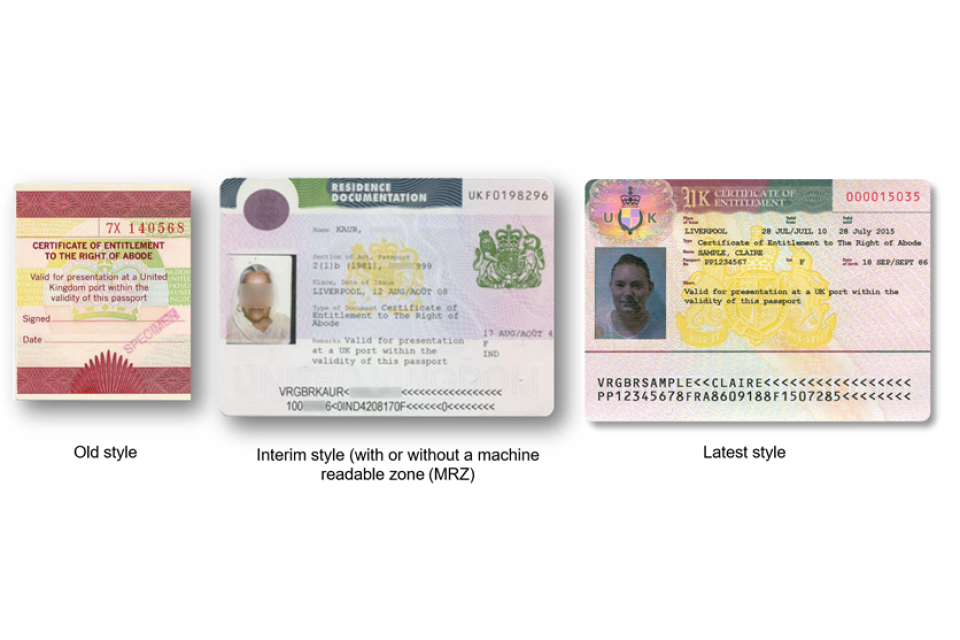
Image of old style, interim style and the latest style.
These vignettes (stickers) are evidence of the holder’s right of abode in the UK. They are affixed inside the holder’s foreign passport. They provide evidence that the holder is entitled to travel to, or live, in the UK.
Indefinite leave to remain (ILR) stamps and vignettes

Image shows Home Office and immigration officer date ink stamp for ILR.
ILR stamps and vignettes allow a non EU/EEA national to remain indefinitely in the UK. They were last issued in August 2006 having been replaced by the residence permit. However, there are many in circulation because they have no expiry date.
Category D entry clearance

Example of how a Category D visa looks.
A Category D entry clearance is a visa to enter the United Kingdom for a period of 6 months or more. They can typically be endorsed with a variety of conditions/restrictions, for example, as a spouse, to work, or to join family. They can also grant indefinite leave to enter.
United Kingdom residence permit (UKRP)
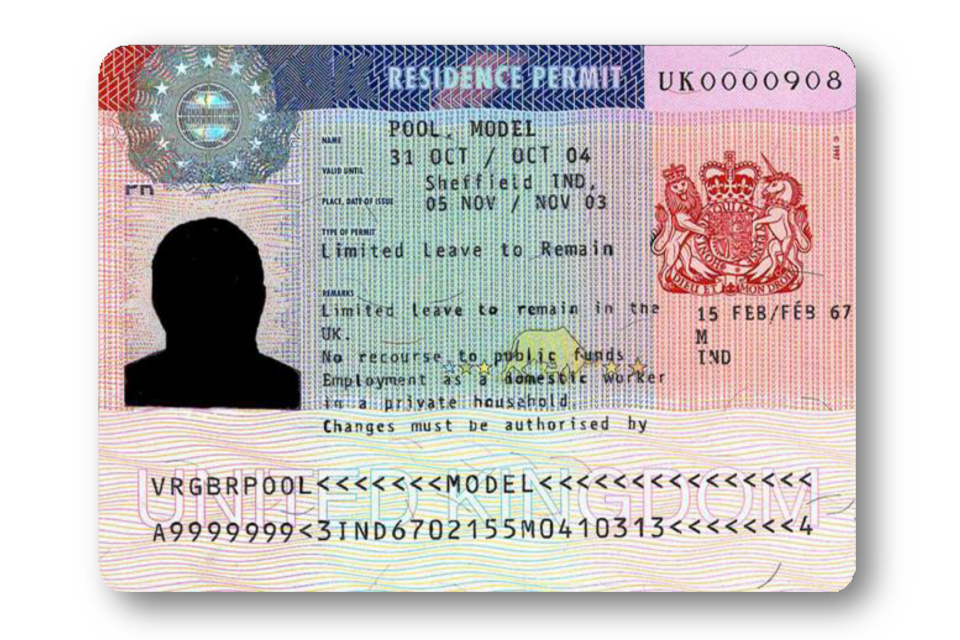
Example of how a UK resident permit looks.
This is a residence permit that replaced the green ILR vignettes and ink stamp endorsements that were previously used (see Category D entry clearance). They give permission to reside in the UK for the purpose stated on the vignette, e.g., student or work permit holder.
First issued in 2003, this is placed into a passport or onto an ‘Immigration Status Document’ (ISD - a white piece of A4 paper). They were last issued in 2012 and were replaced by the biometric residence permit.
Biometric residence permit (BRP)
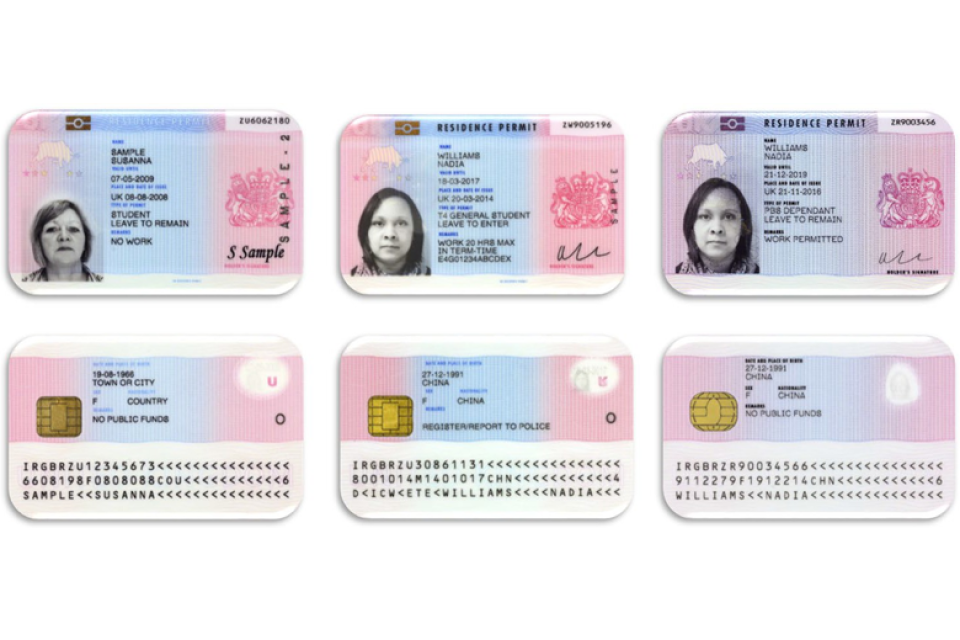
Image of 3 versions of the biometric residence permit.
A person will usually have a valid UKRP or BRP. Introduced from November 2008, BRPs give permission to reside in the UK. There are 4 different versions, the first 3 versions are shown above.
Biometric residence permit (BRP) - 2021

Example of biometric residence permit design from 2021 onwards.
From the beginning of January 2021, the United Kingdom biometric residence permit (BRP) has received a number of design changes. Whilst the card is ostensibly similar to previous versions these changes may be noticed by anybody closely examining the document.
Visit visa

Example of a visit visa.
Not allowed to work/maximum 6 month stay
These visas are issued to visitors to the UK – they are valid for a maximum stay of 6 months and holders are not allowed to undertake paid or voluntary work in the UK.
Home Office travel documents
In all cases, the holder’s status (leave to enter or remain) in the UK will be recorded on the observations page.

Examples of original UK passports and new biometric versions.
Why abuse an identity document?
-
Illegal working
-
Immigration abuse
-
Financial fraud
-
Benefit fraud
Types of document abuse
Impersonation
The person is simply a “look-alike” presenting a genuine document.
Counterfeits
A complete reproduction from scratch to resemble an officially issued document.
Forgeries
A genuine document that has been unlawfully altered in some way, for example:
-
substituting a page
-
substituting a photograph or image
-
altering the personal details
Pseudo/fantasy documents
Documents which may have the physical appearance of a passport or identity card but are not officially recognised. They are not acceptable proof of either nationality or identity.
Impersonation
Initial checks
-
Check the signature – can the person recreate it without sight of the document?
-
Does the person in front of you look the correct age?
-
Does the person have any distinguishing features e.g., moles, scars etc?
Comparing features
-
Compare the shape of the face.
-
Look at the features of the face individually.
-
Look at the position of each in relation to the rest of the face.
-
Ears are unique to each person.
Equipment
The following pieces of equipment are easy to obtain and can enhance your ability to detect fraudulent documents. However, the use of this equipment will only be effective if the user has an understanding of secure documents and their security features.
Magnifiers
Standard handheld magnifying glasses can be useful when examining documents to see if they are counterfeit (e.g., looking at print quality), or if they have been forged (e.g., damage around photographs and images).
Ultraviolet (UV) light sources
These are useful tools for identifying whether documents are made from secure paper or UV safeguards are genuine.
Transmitted light
Shining light through paper (e.g. using light from above, a lamp, or a torch) is a useful way to view features such as watermarks, and also any damage to paper.
Document scanners
These can provide a quick and easy way to establish the authenticity of documents presented for identity verification purposes. See more guidance on document scanners.
Security features
Base fluorescence
Here you can see a range of purported secure documents viewed in normal light.
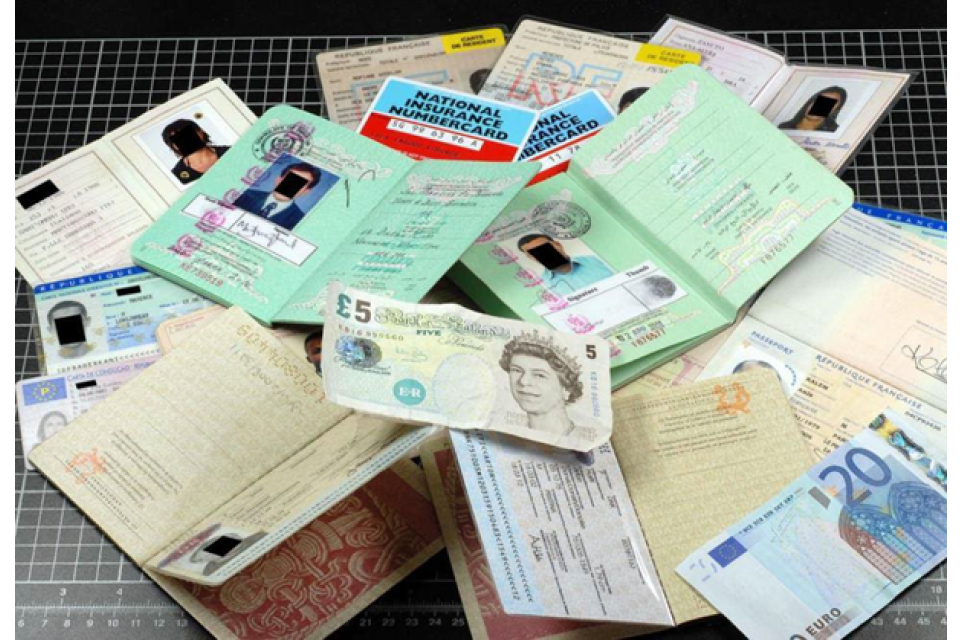
Image of different types of secure documents.
Base fluorescence (using ultraviolet light)
Using ultraviolet (UV) light you can see counterfeit documents that fluoresce (shine) more brightly than genuine documents which use dull, secure paper/material.
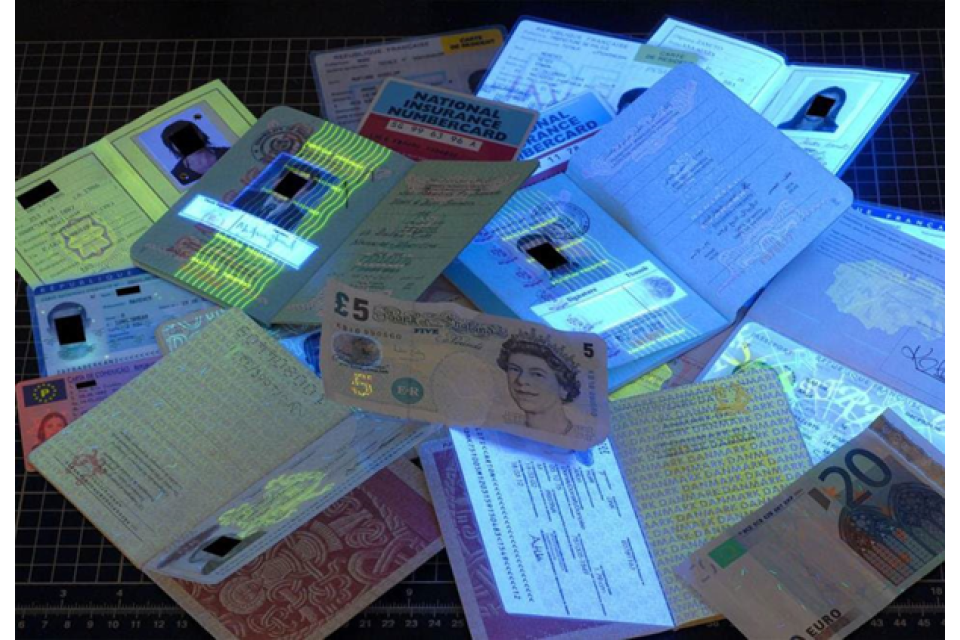
Image of different types of secure documents under ultraviolet light.
Watermarks
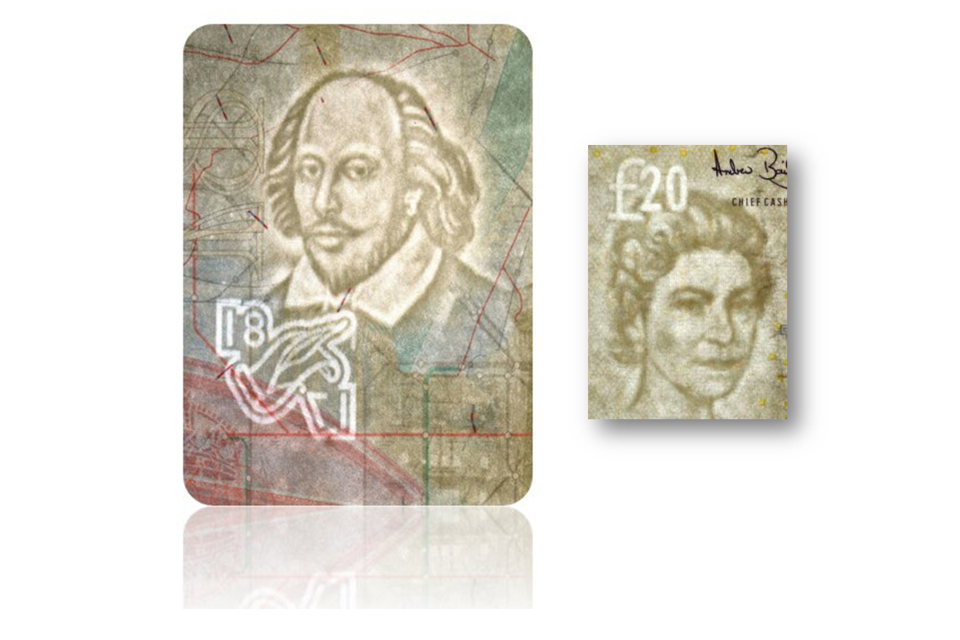
Watermarks found in banknotes.
A watermark is created during the paper manufacturing process by varying the thickness of the paper. It is best viewed using transmitted light (e.g., holding the paper up to a lamp or by shining a torch light through the paper). A real watermark should usually consist of subtle changes in tone and both lighter and darker areas.
A watermark should never react under UV light.
You will notice that many security features in passports can also be found in banknotes.
Random fibres
Security fibres which appear randomly across the paper. They can be visible to the naked eye or react when exposed to UV light.

Shows two versions of random fibres - one normal and one under ultraviolet light.
Background print
Background areas on secure documents are printed to a high standard. Using magnification, solid lines and detailed designs should be visible.

Example of how background areas should look on secure documents.
Intaglio ink
A printing process which results in the in having a raised feel which can be felt by running a finger over the paper. Intaglio printing can be found on the inside cover of most (but not all) passports. You can often find a hidden pattern, revealed when the page is viewed at an oblique angle. The images below are of the intaglio printed area in a British passport.
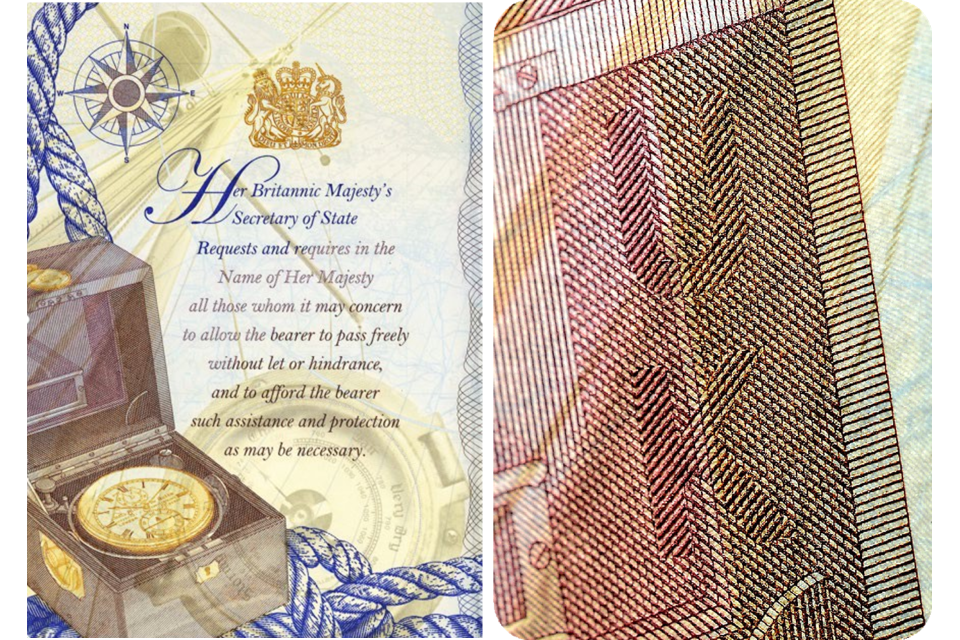
Example of what the intaglio printed area in a British passport looks like.
Optically variable ink
Many secure documents have designs formed of optically variable ink.
A clear colour change from one colour to another should be seen when the document is tilted.

These examples are from a version of the UK driving licence (top) and the BRP (bottom).
Machine readable zone - optical character recognition
Most passports and identity cards have a standardised machine readable zone (MRZ). Below is a chart of the only characters that should be seen in these lines. The presence of any characters that do not match this font exactly could indicate that the document may be a counterfeit or a forgery.
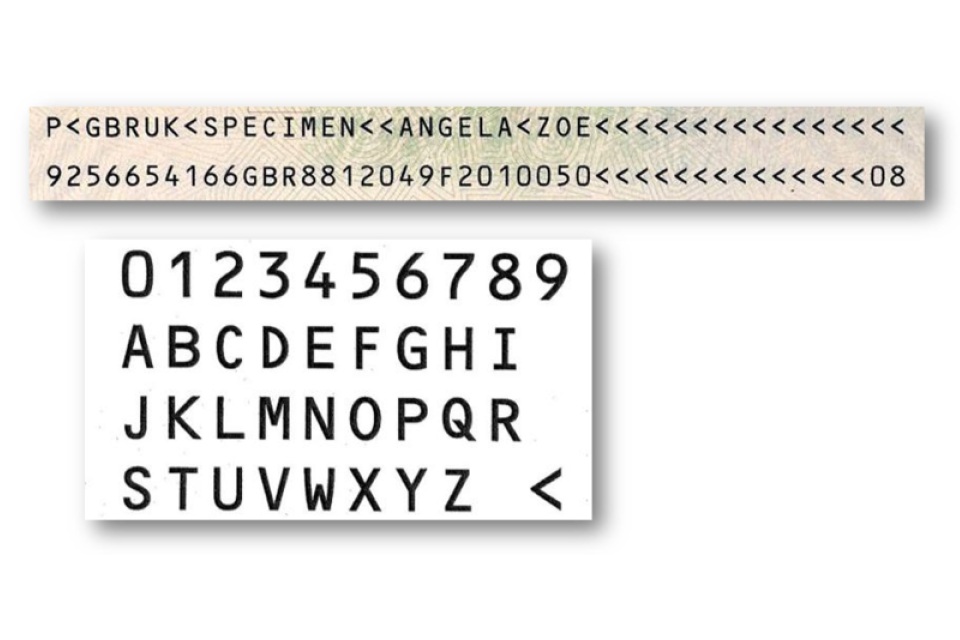
Characters that should be present on passports and identity cards.
N.B. Some countries have issued genuine passports with a non-compliant font within the MRZ.
Counterfeit documents
A counterfeit is a complete reproduction from scratch to resemble an officially issued document. The counterfeiter will often simulate security features that you would expect to see.
-
What is the overall quality of the document?
-
What is the reaction under UV light – bright or dull?
-
Are there watermarks and other paper features e.g. random fibres?
-
Has it been securely printed?
Quality of manufacture

Image comparing two United Arab Emirates passports. One which is genuine and the other which is a counterfeit.
Look at the quality of the document – it should be manufactured to a high standard. Consider the detail of the embossed design on the front (usually gold foil stamped into the cover) and feel the texture of the cover material. Compare the quality and fine detail of the genuine example (left) with the counterfeit (right).
Base fluorescence
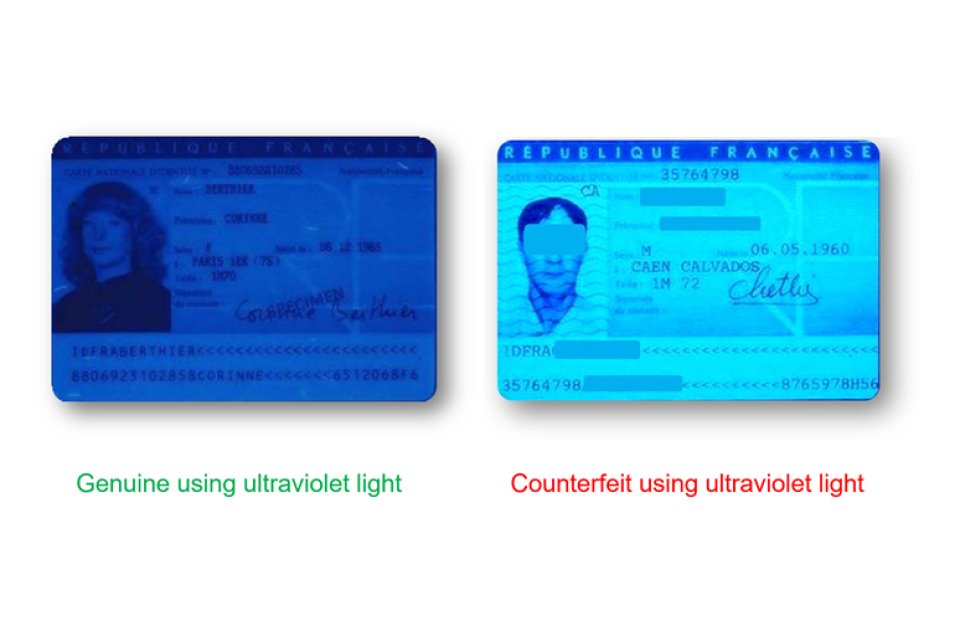
Two ID cards shown - one which is genuine and one that is counterfeit.
Look at the fluorescence (brightness) of the document using ultraviolet light. Note the different reactions – security documents should have a dull reaction.
Watermarks
Nearly all passports contain watermarks (some paper based identity cards also have one). When light is shone through the page the genuine watermark (left) has subtle variations in the light and dark areas (thinner or thicker areas of paper), unlike the counterfeit (right) which has been printed onto the surface.

Two examples of watermarks in a passport in transmitted light - one which is genuine and one that is counterfeit.
Random security fibres
Security fibres appear randomly across the paper. No repeated pattern should be seen as the process is completely random. Looking at 2 pages from a Greek passport (below) under a UV light source, you can see that the fibres on pages 13 and 15 are in the same place. This is not possible in genuine documents.

Image showing where the random security fibres are on a counterfeit document.
Quality of the printing
Look at the quality of the printing - it should be solid lines of high quality.
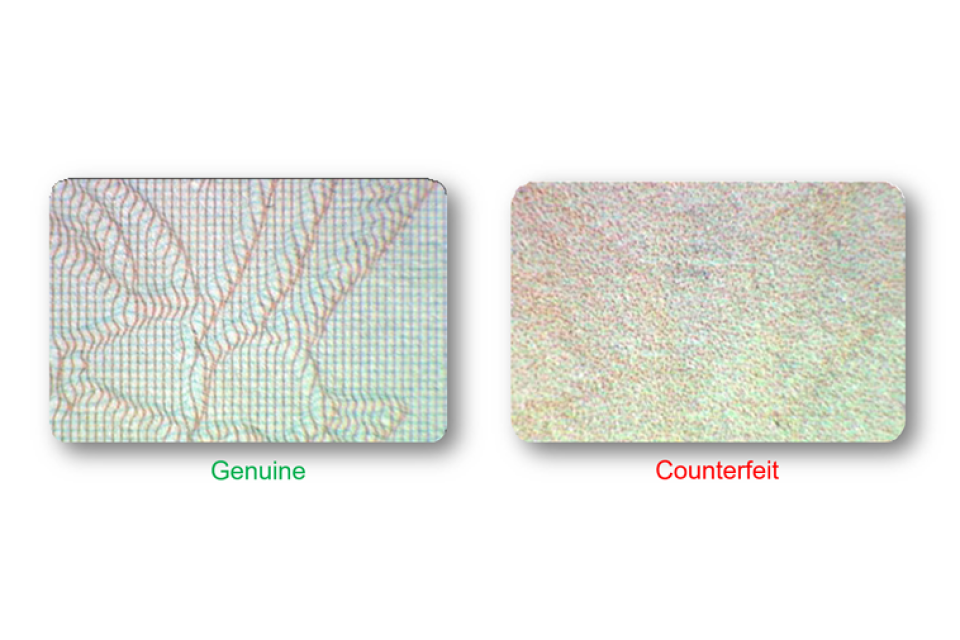
What the quality of printing should look like on genuine document compared to a counterfeit document.
The printed patterns on the pages are deliberately complex, like banknotes, to make copying difficult. The background print in the genuine passport (left) consists of solid fine lines unlike the random dots of the counterfeit (right), a characteristic of readily available home printers. Print quality is often a quick indicator of a counterfeit document. Commercial printing cannot produce the same quality as security printing.
Intaglio (raised) printing
Genuine intaglio printing will have raised print which can be identified by touch. In contrast the counterfeit document on the right does not have raised print.

Genuine intaglio printing compared to counterfeit version.
Holographic devices
Many documents have holographic devices which are highly detailed and display different colours and designs when rotated and tilted. The counterfeit document below has a generic hologram with the word GENUINE in it.
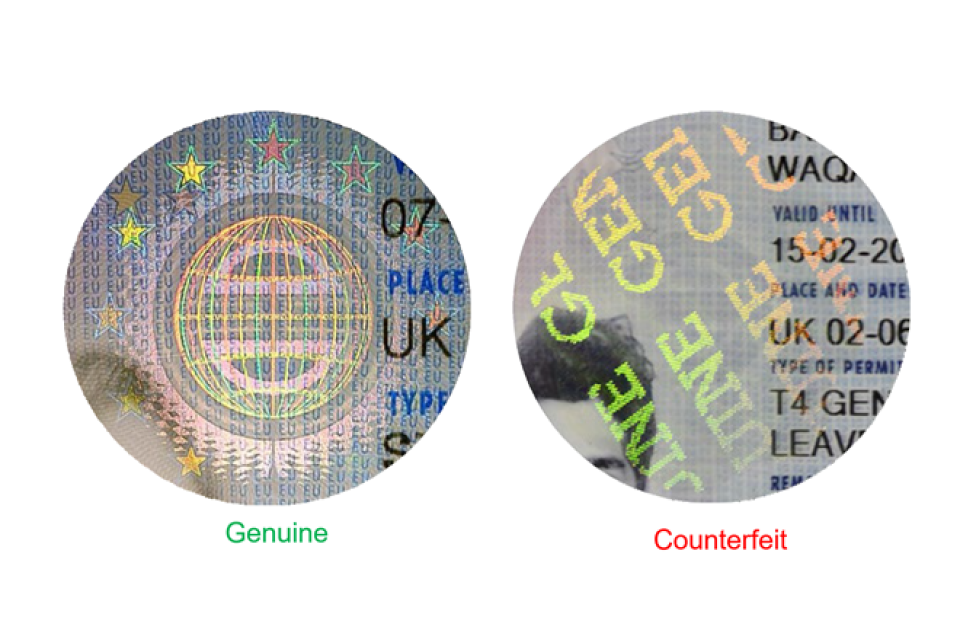
Shows the difference between genuine and counterfeit holograms.
Forged documents
Unlawfully altered documents
There are a number of different ways to alter a genuine document:
-
substitution of a page – usually the bio-data page
-
substitution of the photograph or image
-
alteration of personal details
Substituted pages
Passports are made up from sheets of paper which are then stitched together and cut to size. The pages and cover should therefore all be in perfect alignment. To forge a document it may first be taken apart and then re-assembled by hand, making it difficult for all the pages to sit flush as before.
The machine readable zone (MRZ)
Note the incorrect characters in this machine readable zone (MRZ) on a forged Dutch passport (compare with those set out in Machine readable zone - optical character recognition).

Example of a forged passport that uses a magnified MRZ area.
Substituted photographs and images
Image protection
Most photographs and digital images in passports or ID cards will be protected by an ink stamp, an emboss, or a laminate with visible safeguards.
An ink stamp is produced with wet ink and should not be printed.

Forged Greek ID card with ink stamp highlighted.
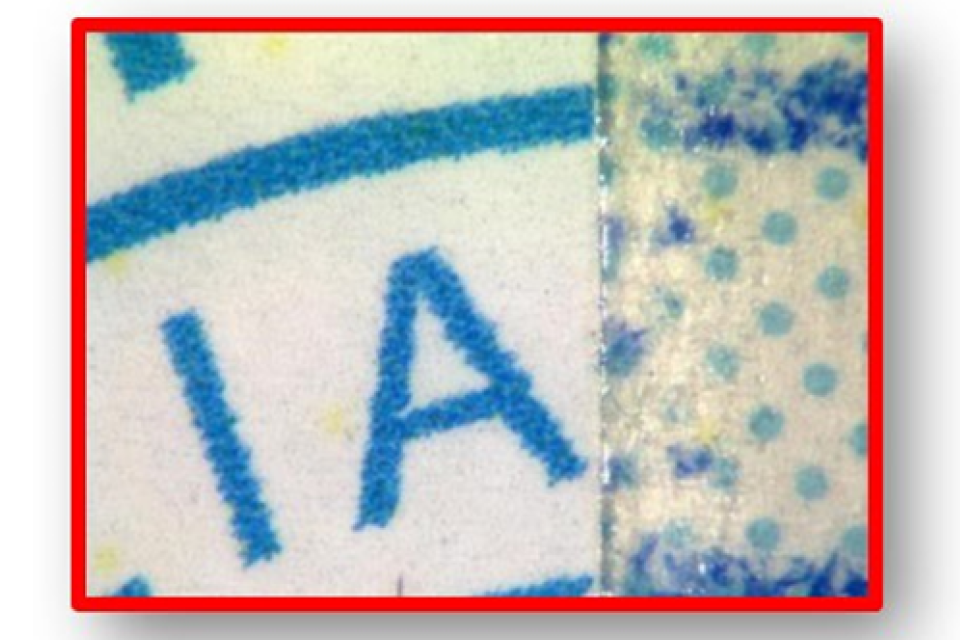
Close up of the forged ink stamp.
Note the printed portion of the stamp on the photograph in the forgery differs from the stamp on the rest of the card.
Printing
Documents have evolved, with most moving away from traditional ‘stuck-in’ photographs. Most paper biodata pages contain images which are digitally printed directly onto the page, as seen in this genuine Portuguese passport. This printed image should not react any differently when viewed under a UV light.
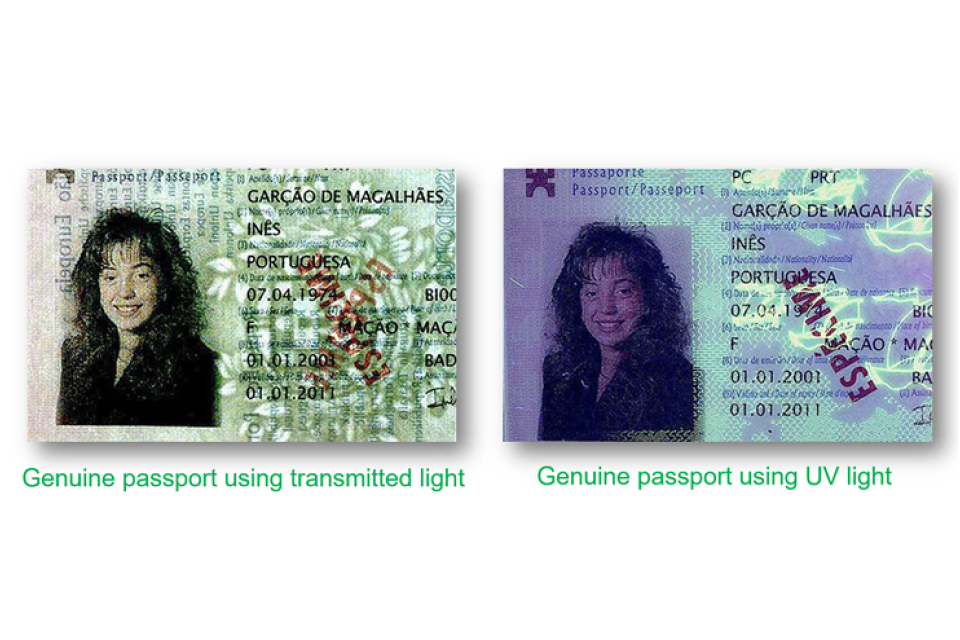
Shows how a genuine passport should look using transmitted light and UV light.
Use different light sources
In this forged Portuguese passport the image has been substituted. The new image has been printed onto a piece of paper and placed onto the page under the laminate. Using a transmitted light source (left) you can see the edges of the new piece of paper. Under a UV light source (right), you can see the new piece of paper fluorescing brightly under UV light - ordinary commercial paper has been used.
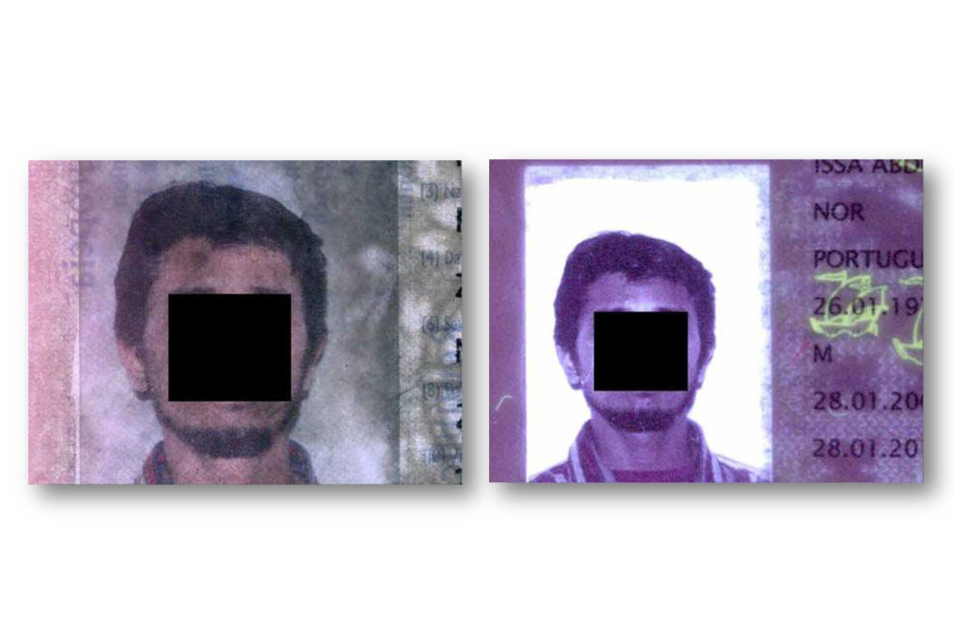
Example of where a forged image has been used and revealed using light sources.
Laminate overlays
Many forgers simply print a new image (or parts of an image) onto a thin clear laminate and place it on top of the page. In this forged USA passport a new face has been added to the original holder’s image. Examine holographic and UV features as the new image may incorrectly sit above them.

Laser engraving
Passports or ID cards made with polycarbonate (a type of plastic) will have a laser engraved image of the holder. This image should display shades of grey/brown (burned carbon). Forgeries usually have printed images which contain jet black or coloured dots. Neither of these should be seen in laser engraved images.

The difference between laser engravings on a genuine and counterfeit image.
Altered details
A forger will often alter details in conjunction with changing a page or photograph/image. The passport has been forged by changing the date of birth. The forger has abraded the original pen ink and then over-written a new date.
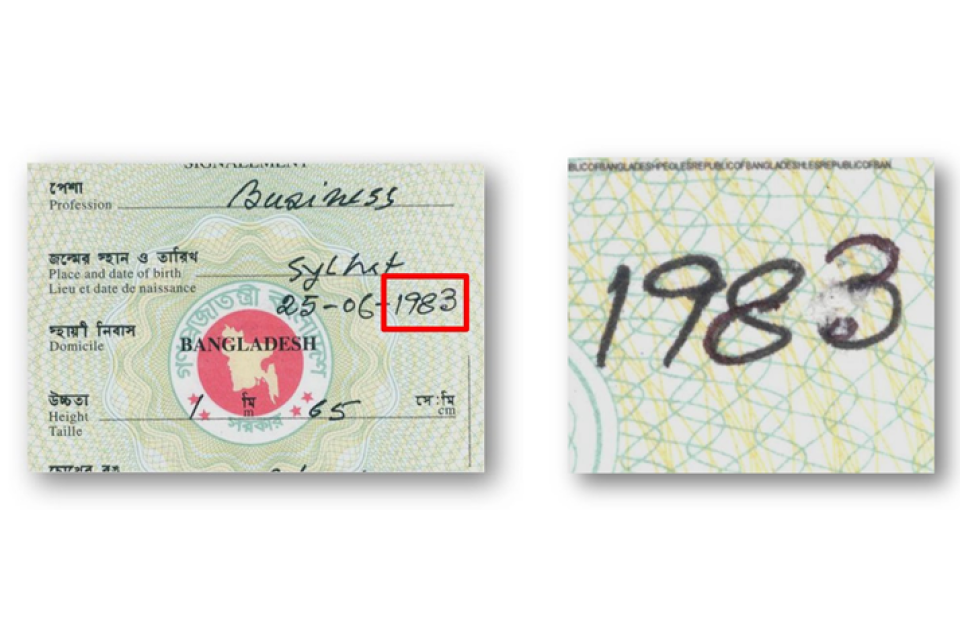
Pseudo/fantasy documents
Pseudo or fantasy documents are ones that have no legal basis; they are normally not based on any legitimate document. They may have the appearance of an official document, are not issued by a legally recognised state authority or institution, or by an organisation recognised under international law, and as such have no legal validity.
Further information
Useful websites
UK government - guidance for employers on UK visa sponsorship
PRADO - information and images of genuine documents, (European and other countries)
EDISON – information and images of genuine documents
CPNI document verification guidance (PDF, 3.59MB
Basic document checks: Checklist A
Cause for concern
Does the document allow the person to live and work in the United Kingdom? (Yes/No)
Is the person presenting the document the same as the image/photograph? (Yes/No)
Is the document genuine or counterfeit? (Yes/No)
Check for:
-
General quality/cover - is it manufactured to a high standard? (Yes/No)
-
Watermarks - view the page with a light source, e.g., a torch or lamp (Yes/No)
-
UV reaction - check if the document reacts dully if a UV light is available (Yes/No)
-
Random fibres - are there random fibres on each of the documents pages? (Yes/No)
-
Print quality - is the quality of the print of a high standard (no dots)? (Yes/No)
-
Intaglio ink on inside cover of passports - is there raised ink on the document? (Yes/No)
-
Optically variable ink - move the document under a light source (Yes/No)
-
Machine readable zone (font) - use an online MRZ checker if available (Yes/No)
-
Holographic devices - move the document under a light source (Yes/No)
Basic document checks: Checklist B
Cause for concern
Have any pages been substituted? (Yes/No)
Check for:
-
Construction/page alignment/page numbers/page design (Yes/No)
-
Counterfeit pages (see above) (Yes/No)
-
Has the photograph/image been substituted?
Check for:
-
Damage around the photograph/image (Yes/No)
-
Any safeguards over photograph/image e.g., ink stamp, emboss, laminate (Yes/No)
-
Correct image type (Yes/No)
-
Evidence of a second laminate – move the document under a light source (Yes/No)
Have any details been altered? (Yes/No)
Check for:
-
Damage to paper around details e.g., date of birth (Yes/No)
-
Is the document a fantasy/pseudo document? – Can you find it on the PRADO or EDISON websites? (Yes/No)
Who do I contact?
If you encounter a suspected false document then contact the police or your local immigration enforcement office.
The originator and owner of the material contained in this presentation is the National Document Fraud Unit, United Kingdom Home Office. The material is protected by Crown Copyright and the images and content should not be used without prior reference to this Unit.
Please note that the information in the presentation was correct at the time of its publication.
